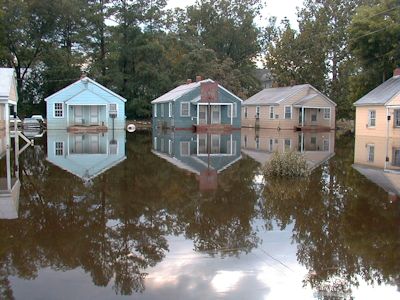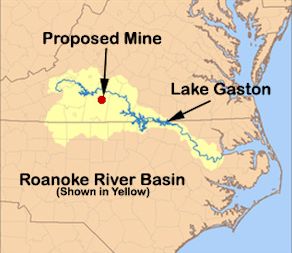 Hurricane Floyd flooded much of Eastern North Carolina. Residents along the Roanoke River wonder what the flood waters would have contained if uranium had been mined just across the state line in Virginia. Photo: Liz Roll, FEMA. |
CHATHAM, VA. — Few in North Carolina will forget Hurricane Floyd, most notable for the vast flooding it brought to interior coastal counties. Not only were homes and businesses inundated, countless hog lagoons overflowed, sending tons of their putrid contents, unchecked and unforeseen, into the pristine estuarine waters.
When talk of permitting uranium mining in the Roanoke River watershed began last year, Tommy Roberson, the mayor of Williamston, N.C., a northeastern city bordered by the river, was reminded how shocked everyone was that the lagoons and their state-approved berms failed so miserably in Floyd.
Supporter Spotlight
But the danger from an unanticipated spill of hog waste pales compared with that of a spill of radioactive material into the river.
“There were a lot of things that happened during that natural disaster that you couldn’t control,” Roberson, a retired businessman, said about the 1999 storm. “Nothing is fail-safe and I just can’t believe that the people of Virginia would allow that risk to their water supply.”
But there are also potentially staggering risks to North Carolina, from the Virginia border all the way to the Outer Banks, said Roberson, chairman of the Roanoke River Mayors’ Association, a coalition of 13 towns. The majority of the water in the Albemarle and the Pamlico sounds, he said, originates from the Roanoke River basin.
“This could ruin the entire habitat of the Eastern North Carolina,” Roberson said. “My goodness, it would be catastrophic for Eastern North Carolina. The radioactivity is something that doesn’t go away.”
Uranium mining is currently banned in Virginia, but under the direction of Gov. Bob McDonnell, the possibility of lifting the 30-year-old ban has been under study since January. A final report is expected to be submitted to the governor on Dec. 1, and a public presentation of the study’s findings will be made in mid-December to the General Assembly’s Coal and Energy Commission.
Supporter Spotlight
 The mine would be in the heart of the Roanoke River Basin. |
“To be honest, I am really appalled with the governor of Virginia, that he’s pushing this,” Roberson said. “I know he’s pro-business, but so I am.”
The reality is, the mayor said, that sometimes what a corporation says it will do does not match what is actually done.
“I’ve worked for a large national company,” he said. “You see what goes on with environmental things.”
A huge deposit of uranium was discovered in 1978 on Coles Hill, near Chatham in Pittsylvania County. Legislators placed a temporary moratorium on uranium mining four years later, prohibiting the practice until a program is “permitted by statute.”
Virginia Uranium Inc. renewed interest in the site around 2007, when two studies were launched by the state. One study, by the National Academy of Sciences, raised concerns about uranium tailings — the waste product of uranium cake processing. The tailings, which would be stored on 80 acres in huge pools, contain a substantial level of radioactivity that could contaminate local waters, the study said.
“Tailings disposal sites represent significant potential sources of contamination for thousands of years, and the long-term risks remain poorly defined,” the report said.
The other state-commissioned study, by Chmura Economics, showed, according to the company’s Web site, that a full-scale mining and milling operation at Coles Hill would support 1,000 jobs, provide $112 million in state and local tax revenue and generate $5 billion for Virginia companies over the 35-year lifespan of the mine.
The company compared the Coles Hill site to one in Bessines, France, that was mined for uranium for about 50 years starting in the late 1940s.
“Bessines has strikingly similar rainfall and humidity levels to Pittsylvania County,” the Web site said, “which boasts significant beef and dairy cattle production, and accommodates a much higher population density than Pittsylvania County.”
And another former uranium mine in France, the Web site said, is now the site of a trout fishing pond.
But Virginia is subject to something France is not — hurricanes.
 Tom Reeder |
In a Nov. 15 presentation to the N.C. General Assembly’s Environmental Review Commission, Tom Reeder, the director of the state Division of Water Resources, said if the containment ponds for the tailings are breeched during a storm, the contamination could theoretically make its way through the lakes and tributaries to the Albemarle Sound. The water could be radioactive for at least two years, but even after the contaminated particles are disbursed and settle to the bottom, storms can stir them up indefinitely.
“So basically, the problem would be you have this initial period of radioactivity in the lake,” Reeder said in a telephone interview. “And then it’s trapped in the sediments. That’s really the scary thing. Once this stuff is in the environment, it’s very difficult to get rid of.”
In his presentation, Reeder said that the proposed mine could produce about 11 million cubic yards of radioactive tailings in the above-ground storage impoundments.
According to the presentation, a breach could affect the water supply of 118,760 North Carolinians and up to 64 agricultural operations in Eastern North Carolina counties. A radioactive spill would also impact the annual $15 million Kerr Lake and Lake Gaston earns in tourism and recreation dollars, as well as harm the striped bass fishery and the recovery of the sturgeon fishery.
“The radiation effect would move throughout the chain of life and the fish would be contaminated,” Reeder said in the interview. “The fish would be destroyed all the way to the sound.”
Reeder said that uranium mining in the U.S. has only been done in arid, stable areas, and never in areas like Virginia that are subject to intense storms. Even so, he said, there are a number of former uranium mines out West that are now environmental Superfund sites.
A current environmental disaster related to uranium illustrates that accidents do happen, despite the best intentions of the company. The Talvivaara’s Sotkamo mine in Finland, granted a permit in March to mine uranium, was recently found to have leaked high levels of radioactive wastewater into waters near the plant, according to a Nov. 9 article published by Reuters. Production has been shut down while the company searches for the source of the leak.
In an earlier Reuters article, published March 1, 2012, the CEO of Talvivaara, Pekka Pera, said that the company, which primarily mines nickel and zinc, was looking forward to maximizing the value of its ore by mining the uranium byproduct.
“We are very pleased to have been granted this license, which is not only a further step towards uranium production at Talvivaara, but also a confirmation that our recovery process meets the highest safety and environmental standards.”
 More than a thousand protesters gathered in Helsinki in March to force Talvivaara to shut down its leaking uranium mine in Finland. |
Also, the epicenter of a 5.8 earthquake that struck on Aug. 23 2011 was in central Virginia. According to the U.S. Geological Survey, the quake was felt by more people than any other on record, meaning that an earthquake at that Virginia fault line has the potential to do widespread damage.
According to draft minutes of the ERC meeting, Rep. Mitch Gillespie, a Republican from Marion and co-chairman of the commission, asked that Reeder’s presentation be included in the transition documents for the new governor and state legislators. Gillespie also said that the committee will send a resolution to the North Carolina congressional delegation in support of the uranium ban.
Fourteen organizations and local governments in North Carolina have passed resolutions in opposition to lifting the ban. The Roanoke River Bi-State Commission has members from both states who support keeping the ban.
In Virginia, a group of local and state organizations opposed to uranium mining in the state called the Keep the Ban Coalition said on its Web site that more than 100 government entities and nonprofit groups and 16,000 citizens have voiced support for the ban.
Virginia Beach gets much of its drinking water from Lake Gaston, which is fed by the Roanoke River. The river is also renowned for its world-class striped bass fishing.
Mike Pucci, a Lake Gaston resident and the chairman of the North Carolina Coalition Against Uranium Mining, said that the radioactive material in the tailing ponds has a 300,000-year lifespan. No matter the potential financial benefit to Virginia, he said, it’s “inappropriate” to allow a uranium mine in an area that is in a hurricane zone and in the vicinity of an active earthquake fault.
“Yeah, it’s a lot of money,” he said, “but you try replacing the water supply for two million people.”
Pucci said that Raleigh has petitioned the Corps of Engineers to pull 50 million gallons of water from Kerr Lake, a reservoir fed by the Roanoke, to provide for future growth. And the Triangle region, which has so far attracted about 150 biotech companies, cannot continue to grow without water.
“There’s nothing in this for North Carolina,” Pucci said. “We carry all the risk and we get nothing in this enterprise. So if the governor is acting in the interest of his state, he needs to raise his voice and oppose it.”







